key CHEVROLET EXPRESS CARGO VAN 2007 1.G User Guide
[x] Cancel search | Manufacturer: CHEVROLET, Model Year: 2007, Model line: EXPRESS CARGO VAN, Model: CHEVROLET EXPRESS CARGO VAN 2007 1.GPages: 458, PDF Size: 2.62 MB
Page 105 of 458
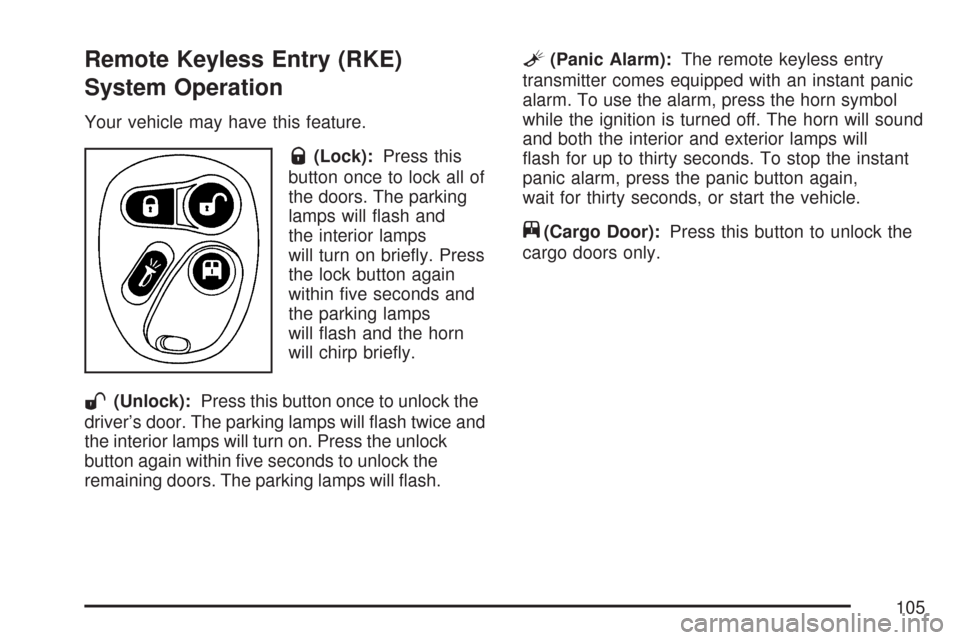
Remote Keyless Entry (RKE)
System Operation
Your vehicle may have this feature.
Q(Lock):Press this
button once to lock all of
the doors. The parking
lamps will flash and
the interior lamps
will turn on briefly. Press
the lock button again
within five seconds and
the parking lamps
will flash and the horn
will chirp briefly.
W(Unlock):Press this button once to unlock the
driver’s door. The parking lamps will flash twice and
the interior lamps will turn on. Press the unlock
button again within five seconds to unlock the
remaining doors. The parking lamps will flash.
L(Panic Alarm):The remote keyless entry
transmitter comes equipped with an instant panic
alarm. To use the alarm, press the horn symbol
while the ignition is turned off. The horn will sound
and both the interior and exterior lamps will
flash for up to thirty seconds. To stop the instant
panic alarm, press the panic button again,
wait for thirty seconds, or start the vehicle.
j(Cargo Door):Press this button to unlock the
cargo doors only.
105
Page 106 of 458
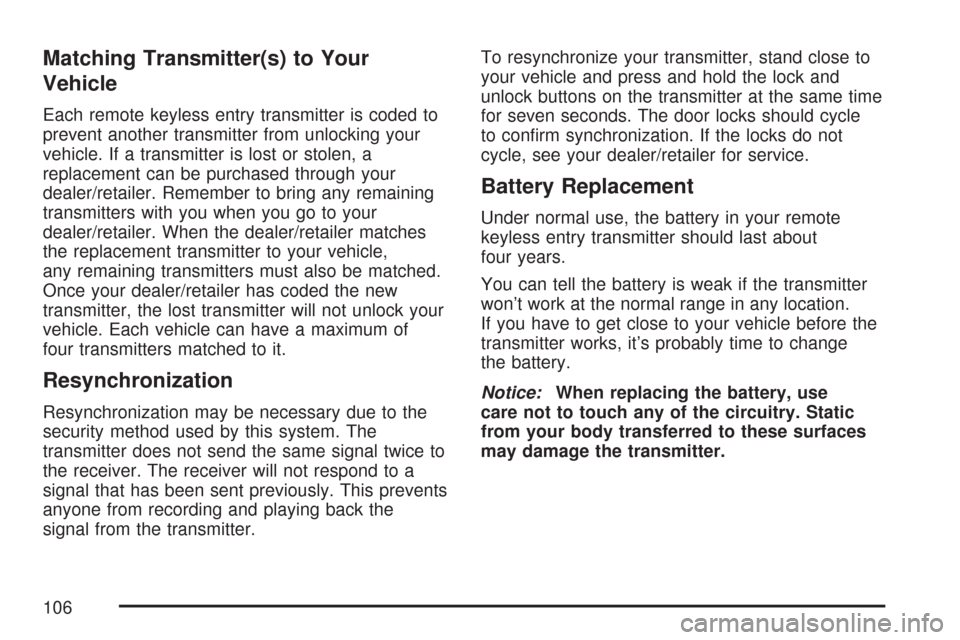
Matching Transmitter(s) to Your
Vehicle
Each remote keyless entry transmitter is coded to
prevent another transmitter from unlocking your
vehicle. If a transmitter is lost or stolen, a
replacement can be purchased through your
dealer/retailer. Remember to bring any remaining
transmitters with you when you go to your
dealer/retailer. When the dealer/retailer matches
the replacement transmitter to your vehicle,
any remaining transmitters must also be matched.
Once your dealer/retailer has coded the new
transmitter, the lost transmitter will not unlock your
vehicle. Each vehicle can have a maximum of
four transmitters matched to it.
Resynchronization
Resynchronization may be necessary due to the
security method used by this system. The
transmitter does not send the same signal twice to
the receiver. The receiver will not respond to a
signal that has been sent previously. This prevents
anyone from recording and playing back the
signal from the transmitter.To resynchronize your transmitter, stand close to
your vehicle and press and hold the lock and
unlock buttons on the transmitter at the same time
for seven seconds. The door locks should cycle
to confirm synchronization. If the locks do not
cycle, see your dealer/retailer for service.
Battery Replacement
Under normal use, the battery in your remote
keyless entry transmitter should last about
four years.
You can tell the battery is weak if the transmitter
won’t work at the normal range in any location.
If you have to get close to your vehicle before the
transmitter works, it’s probably time to change
the battery.
Notice:When replacing the battery, use
care not to touch any of the circuitry. Static
from your body transferred to these surfaces
may damage the transmitter.
106
Page 107 of 458
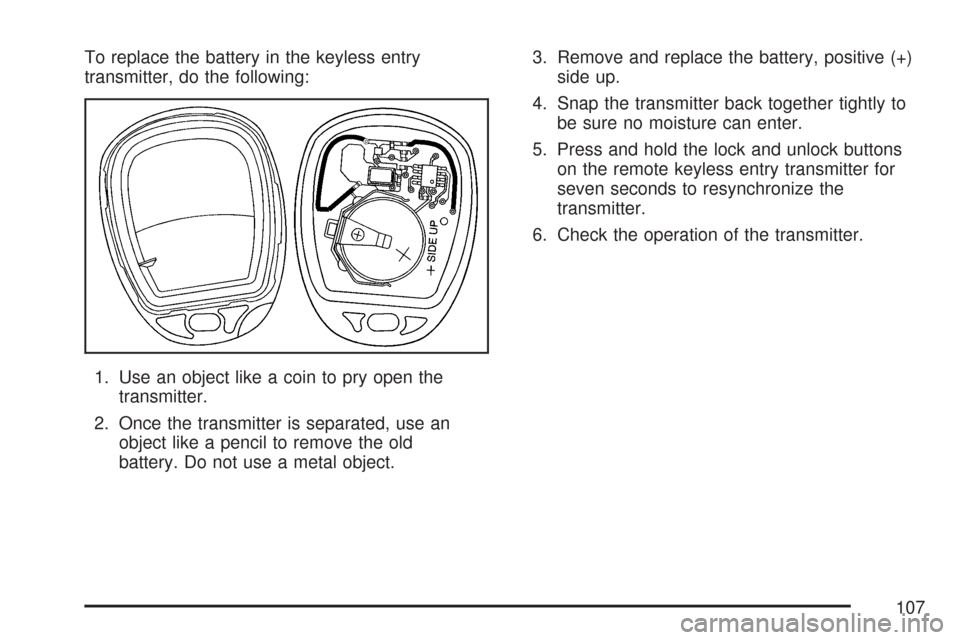
To replace the battery in the keyless entry
transmitter, do the following:
1. Use an object like a coin to pry open the
transmitter.
2. Once the transmitter is separated, use an
object like a pencil to remove the old
battery. Do not use a metal object.3. Remove and replace the battery, positive (+)
side up.
4. Snap the transmitter back together tightly to
be sure no moisture can enter.
5. Press and hold the lock and unlock buttons
on the remote keyless entry transmitter for
seven seconds to resynchronize the
transmitter.
6. Check the operation of the transmitter.
107
Page 109 of 458
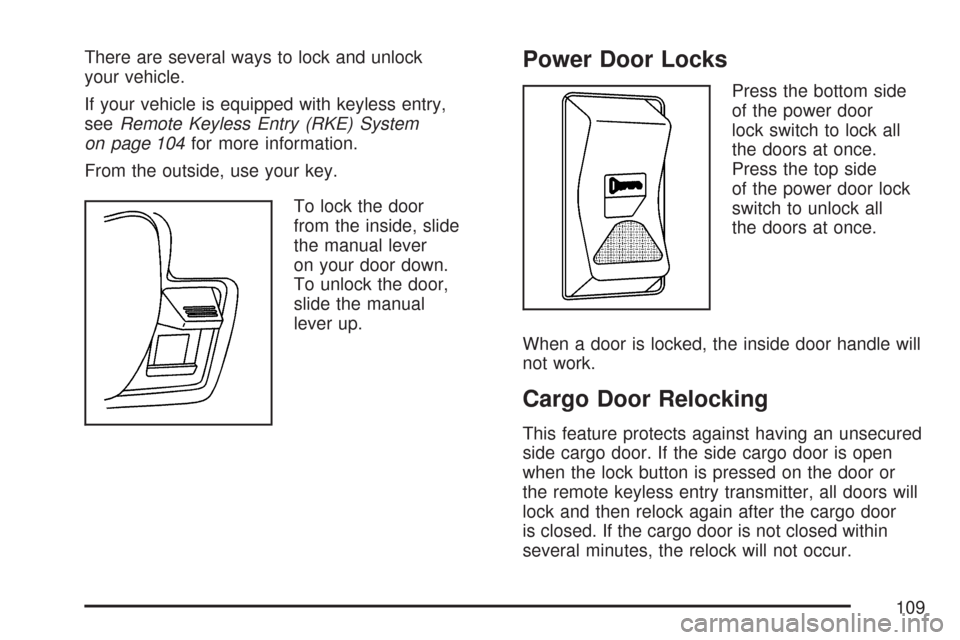
There are several ways to lock and unlock
your vehicle.
If your vehicle is equipped with keyless entry,
seeRemote Keyless Entry (RKE) System
on page 104for more information.
From the outside, use your key.
To lock the door
from the inside, slide
the manual lever
on your door down.
To unlock the door,
slide the manual
lever up.Power Door Locks
Press the bottom side
of the power door
lock switch to lock all
the doors at once.
Press the top side
of the power door lock
switch to unlock all
the doors at once.
When a door is locked, the inside door handle will
not work.
Cargo Door Relocking
This feature protects against having an unsecured
side cargo door. If the side cargo door is open
when the lock button is pressed on the door or
the remote keyless entry transmitter, all doors will
lock and then relock again after the cargo door
is closed. If the cargo door is not closed within
several minutes, the relock will not occur.
109
Page 110 of 458
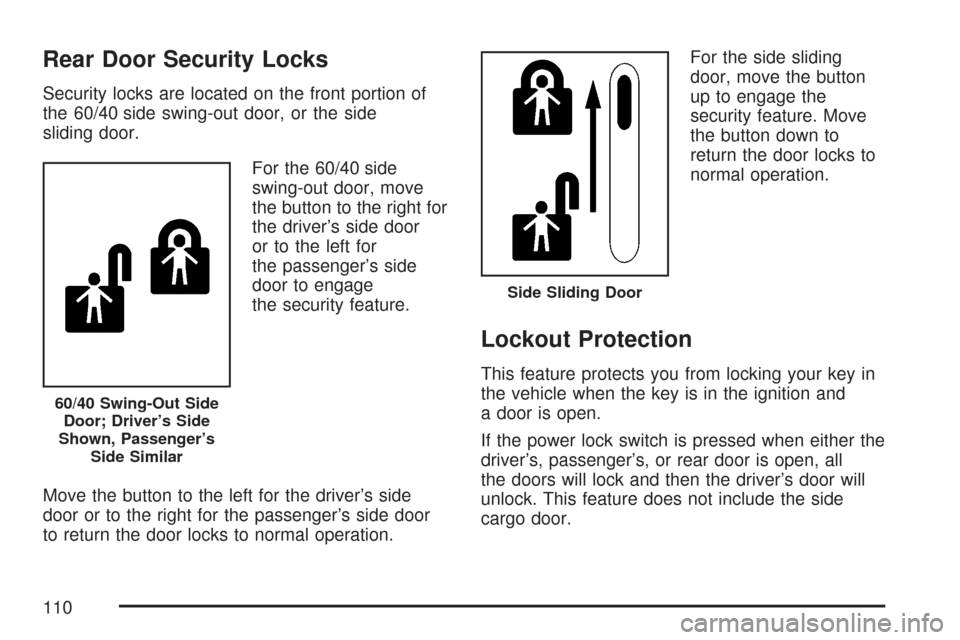
Rear Door Security Locks
Security locks are located on the front portion of
the 60/40 side swing-out door, or the side
sliding door.
For the 60/40 side
swing-out door, move
the button to the right for
the driver’s side door
or to the left for
the passenger’s side
door to engage
the security feature.
Move the button to the left for the driver’s side
door or to the right for the passenger’s side door
to return the door locks to normal operation.For the side sliding
door, move the button
up to engage the
security feature. Move
the button down to
return the door locks to
normal operation.
Lockout Protection
This feature protects you from locking your key in
the vehicle when the key is in the ignition and
a door is open.
If the power lock switch is pressed when either the
driver’s, passenger’s, or rear door is open, all
the doors will lock and then the driver’s door will
unlock. This feature does not include the side
cargo door.
60/40 Swing-Out Side
Door; Driver’s Side
Shown, Passenger’s
Side Similar
Side Sliding Door
110
Page 118 of 458
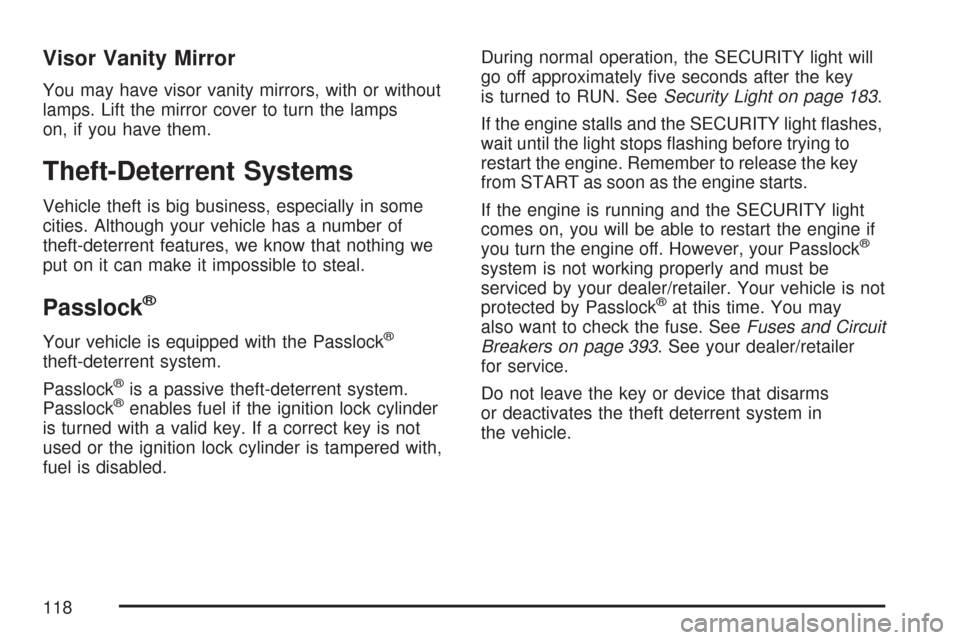
Visor Vanity Mirror
You may have visor vanity mirrors, with or without
lamps. Lift the mirror cover to turn the lamps
on, if you have them.
Theft-Deterrent Systems
Vehicle theft is big business, especially in some
cities. Although your vehicle has a number of
theft-deterrent features, we know that nothing we
put on it can make it impossible to steal.
Passlock®
Your vehicle is equipped with the Passlock®
theft-deterrent system.
Passlock
®is a passive theft-deterrent system.
Passlock®enables fuel if the ignition lock cylinder
is turned with a valid key. If a correct key is not
used or the ignition lock cylinder is tampered with,
fuel is disabled.During normal operation, the SECURITY light will
go off approximately five seconds after the key
is turned to RUN. SeeSecurity Light on page 183.
If the engine stalls and the SECURITY light flashes,
wait until the light stops flashing before trying to
restart the engine. Remember to release the key
from START as soon as the engine starts.
If the engine is running and the SECURITY light
comes on, you will be able to restart the engine if
you turn the engine off. However, your Passlock
®
system is not working properly and must be
serviced by your dealer/retailer. Your vehicle is not
protected by Passlock
®at this time. You may
also want to check the fuse. SeeFuses and Circuit
Breakers on page 393. See your dealer/retailer
for service.
Do not leave the key or device that disarms
or deactivates the theft deterrent system in
the vehicle.
118
Page 120 of 458
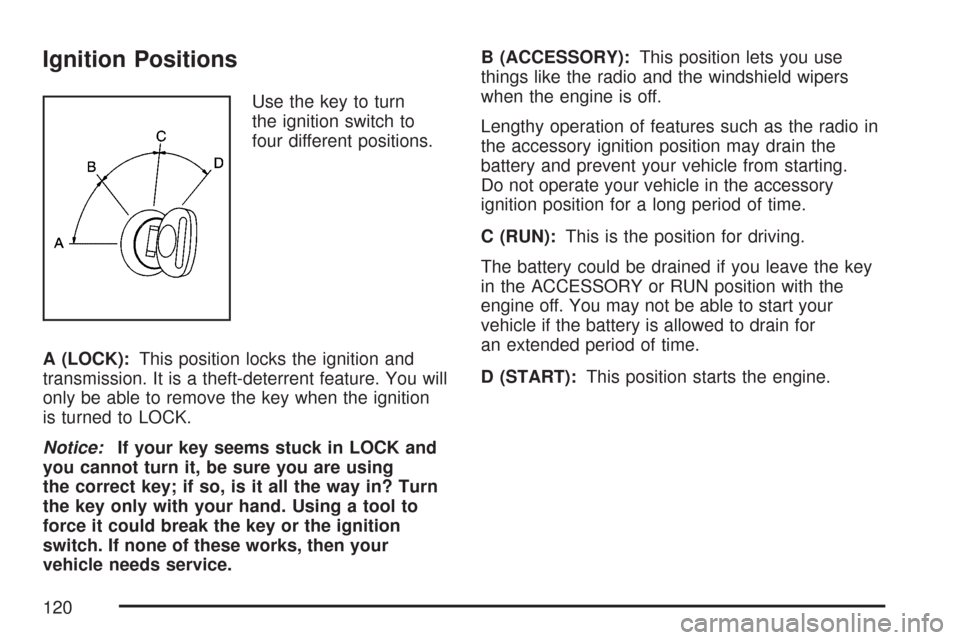
Ignition Positions
Use the key to turn
the ignition switch to
four different positions.
A (LOCK):This position locks the ignition and
transmission. It is a theft-deterrent feature. You will
only be able to remove the key when the ignition
is turned to LOCK.
Notice:If your key seems stuck in LOCK and
you cannot turn it, be sure you are using
the correct key; if so, is it all the way in? Turn
the key only with your hand. Using a tool to
force it could break the key or the ignition
switch. If none of these works, then your
vehicle needs service.B (ACCESSORY):This position lets you use
things like the radio and the windshield wipers
when the engine is off.
Lengthy operation of features such as the radio in
the accessory ignition position may drain the
battery and prevent your vehicle from starting.
Do not operate your vehicle in the accessory
ignition position for a long period of time.
C (RUN):This is the position for driving.
The battery could be drained if you leave the key
in the ACCESSORY or RUN position with the
engine off. You may not be able to start your
vehicle if the battery is allowed to drain for
an extended period of time.
D (START):This position starts the engine.
120
Page 121 of 458
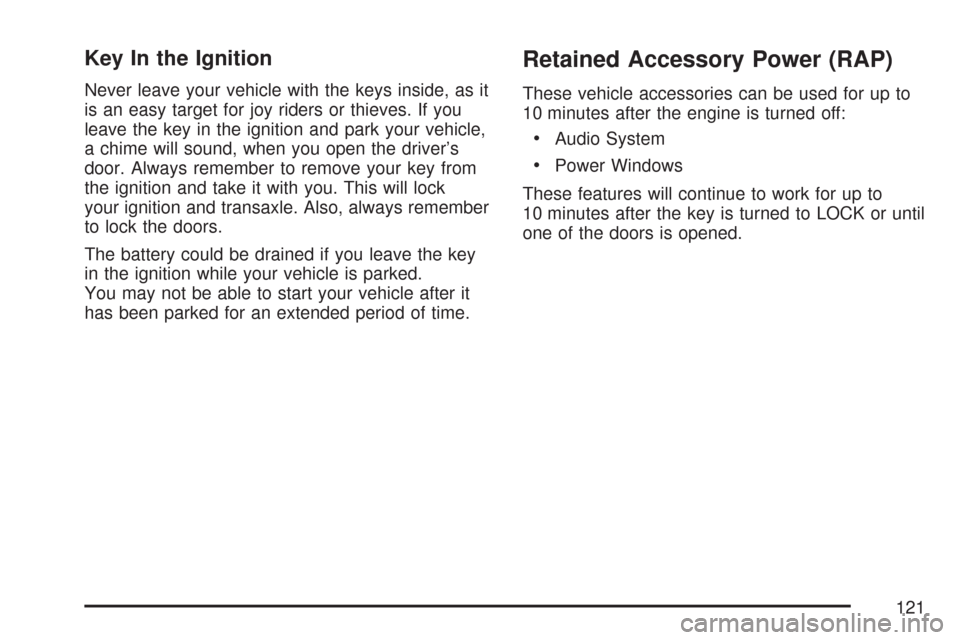
Key In the Ignition
Never leave your vehicle with the keys inside, as it
is an easy target for joy riders or thieves. If you
leave the key in the ignition and park your vehicle,
a chime will sound, when you open the driver’s
door. Always remember to remove your key from
the ignition and take it with you. This will lock
your ignition and transaxle. Also, always remember
to lock the doors.
The battery could be drained if you leave the key
in the ignition while your vehicle is parked.
You may not be able to start your vehicle after it
has been parked for an extended period of time.
Retained Accessory Power (RAP)
These vehicle accessories can be used for up to
10 minutes after the engine is turned off:
•Audio System
•Power Windows
These features will continue to work for up to
10 minutes after the key is turned to LOCK or until
one of the doors is opened.
121
Page 122 of 458
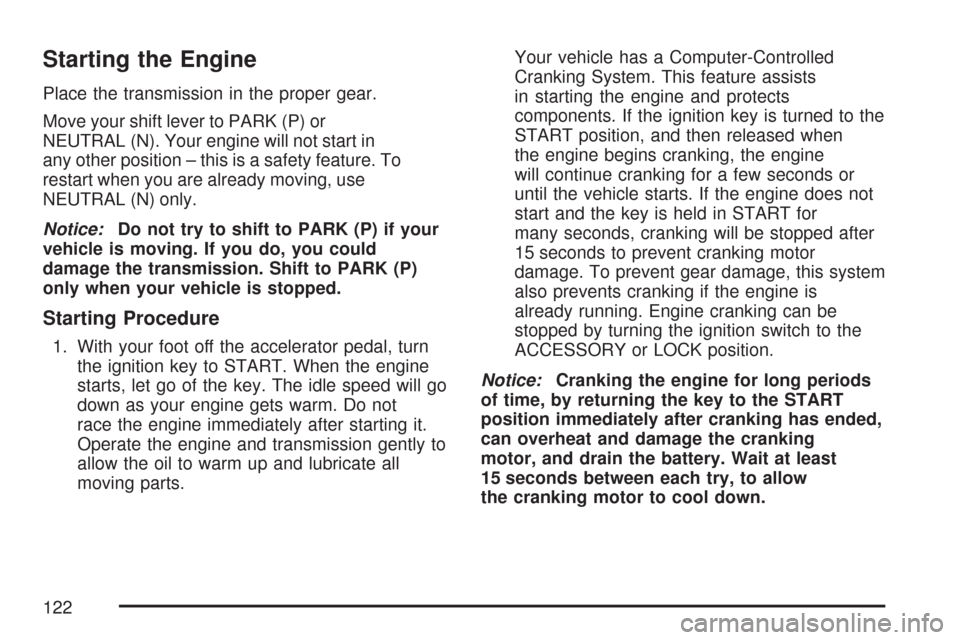
Starting the Engine
Place the transmission in the proper gear.
Move your shift lever to PARK (P) or
NEUTRAL (N). Your engine will not start in
any other position – this is a safety feature. To
restart when you are already moving, use
NEUTRAL (N) only.
Notice:Do not try to shift to PARK (P) if your
vehicle is moving. If you do, you could
damage the transmission. Shift to PARK (P)
only when your vehicle is stopped.
Starting Procedure
1. With your foot off the accelerator pedal, turn
the ignition key to START. When the engine
starts, let go of the key. The idle speed will go
down as your engine gets warm. Do not
race the engine immediately after starting it.
Operate the engine and transmission gently to
allow the oil to warm up and lubricate all
moving parts.Your vehicle has a Computer-Controlled
Cranking System. This feature assists
in starting the engine and protects
components. If the ignition key is turned to the
START position, and then released when
the engine begins cranking, the engine
will continue cranking for a few seconds or
until the vehicle starts. If the engine does not
start and the key is held in START for
many seconds, cranking will be stopped after
15 seconds to prevent cranking motor
damage. To prevent gear damage, this system
also prevents cranking if the engine is
already running. Engine cranking can be
stopped by turning the ignition switch to the
ACCESSORY or LOCK position.
Notice:Cranking the engine for long periods
of time, by returning the key to the START
position immediately after cranking has ended,
can overheat and damage the cranking
motor, and drain the battery. Wait at least
15 seconds between each try, to allow
the cranking motor to cool down.
122
Page 123 of 458
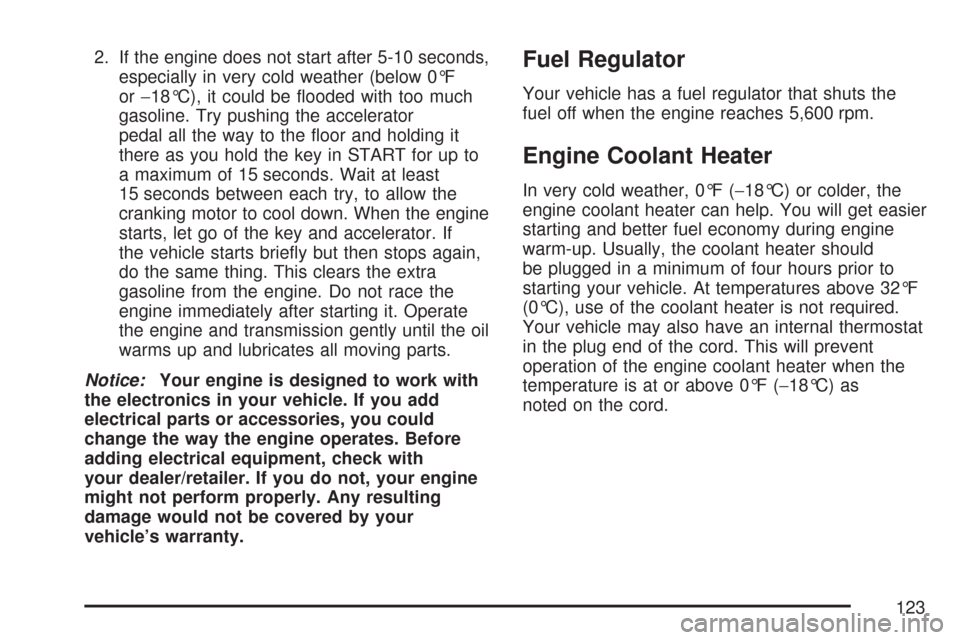
2. If the engine does not start after 5-10 seconds,
especially in very cold weather (below 0°F
or−18°C), it could be flooded with too much
gasoline. Try pushing the accelerator
pedal all the way to the floor and holding it
there as you hold the key in START for up to
a maximum of 15 seconds. Wait at least
15 seconds between each try, to allow the
cranking motor to cool down. When the engine
starts, let go of the key and accelerator. If
the vehicle starts briefly but then stops again,
do the same thing. This clears the extra
gasoline from the engine. Do not race the
engine immediately after starting it. Operate
the engine and transmission gently until the oil
warms up and lubricates all moving parts.
Notice:Your engine is designed to work with
the electronics in your vehicle. If you add
electrical parts or accessories, you could
change the way the engine operates. Before
adding electrical equipment, check with
your dealer/retailer. If you do not, your engine
might not perform properly. Any resulting
damage would not be covered by your
vehicle’s warranty.Fuel Regulator
Your vehicle has a fuel regulator that shuts the
fuel off when the engine reaches 5,600 rpm.
Engine Coolant Heater
In very cold weather, 0°F (−18°C) or colder, the
engine coolant heater can help. You will get easier
starting and better fuel economy during engine
warm-up. Usually, the coolant heater should
be plugged in a minimum of four hours prior to
starting your vehicle. At temperatures above 32°F
(0°C), use of the coolant heater is not required.
Your vehicle may also have an internal thermostat
in the plug end of the cord. This will prevent
operation of the engine coolant heater when the
temperature is at or above 0°F (−18°C) as
noted on the cord.
123